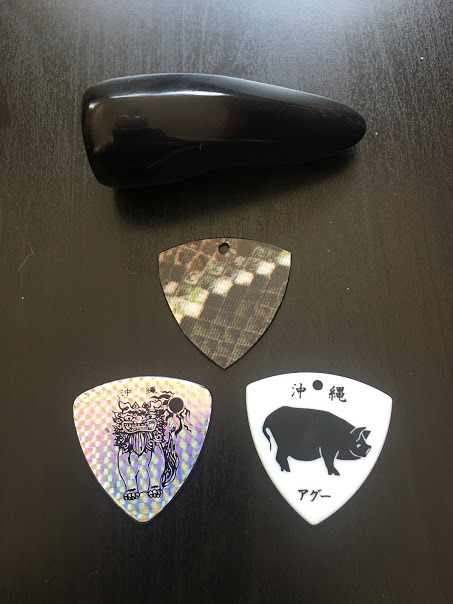#jefeandthethreestring
Text
Anatomy

Before jumping into the music, I wanted to get a good understanding of what the instrument is, what the different parts are, and a bit about it’s history. I’ll cover the history of the instrument in the next post, for now I want to go over the different parts. Like with most stringed instruments, there are three main parts of the Sanshin, The body, the neck and the strings.
The Body (Dou)

What acts as the resonator in the Sanshin body is a snake skin drum called the Dou. The Sanshin I picked up is synthetic snake skin. The reasons I picked this one up were the lower cost, the inability to bring real snake skin back into Canada, and to save one slithery friend’s fate from becoming a guitar (even though that’s super metal). Although there are plenty of habu snakes in Okinawa, they are actually too small to make a Sanshin body from. Traditionally, Burmese python skins were imported, but due to regulations other varieties of python are imported now.
The drum is wrapped with a decorative sash called the Doumaki. This basically means body wrap or body roll, a pretty straight forward name for it. The design on mine is the symbol of the Ryukyu Kingdom, the original name for the Okinawa island nation. Look to the upcoming post for more information on this.
The Neck (Sou)
The neck is made from one piece of wood and fit through the snake skin drum. Unlike a guitar, the neck of a Sanshin has no frets. There are guide dots on the side of the neck of beginner Sanshins. In an upcoming post I will go into the process of adding some to my own Sanshin.

The strings are held and tuned on the top end of the Sanshin with three pegs called Karakui. Unfortunately one peg snapped when bringing it back from Okinawa. I did manage to fix it with wood glue. Fingers cross that it doesn’t break again. The pegs fit snuggly within the top of the neck. I have to push them in with a fair amount of force so that the strings keep their tune.
Three Strings

Where the Sanshin gets it’s name is from the three strings. Each has it’s own name. The thickest is the male string, then the middle, then the female string as the thinest.
The bridge that holds the strings above the body is called the uma. Supposedly produces a better sound when made of bamboo. This one is made of plastic. When storing the Sanshin, I just flip the uma down to reduce tension on the strings, and when I’m ready to rock I just flip it up and place it about two inches from the base. Surprisingly, it does keep it’s tune sometimes.
The strings are held across the body with the strongly knit knot called Itokake. You can see in the photo that this is wrapped around the end of the neck that passes through the drum.

You can play the Sanshin with a piece called the Bachi. Traditionally made from water bufallo horn. I believe this one is either ceramic or plastic. It’s a bit tricky to use but I think works well for the style of music that is played on it. I picked up a few picks to make playing a bit more familiar and to make performing faster songs easier.
That’s essentially what there is to a Sanshin. Pretty simple instrument with some neat parts. In the next post I’ll go into the history and evolution of the instrument throughout Asia.
3 notes
·
View notes
Text
An Introduction
I’m Jeff, but everyone calls me Jefe (he-fe).
A summarized history of my life is: childhood, high school, guitar teacher, rock band, university, job, hate job, marriage, quit job, stay-at-home-dad-no-kids.
Now that that’s out of the way, what's the point of this?
On a recent trip to Okinawa with my wife, I picked up a local musical instrument called the Sanshin. Which translates to Three String. With a small amount of musical knowledge, minimal English guide material, and whole lot of free time, I set out to learn how to play this Asian Banjo.

Join me as we begin the adventures of Jefe and the Three String!
0 notes